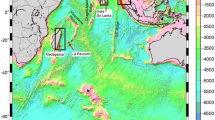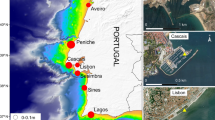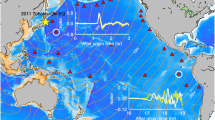Abstract
The M w = 9.1 mega-thrust Sumatra–Andaman earthquake that occurred on December 26, 2004, was followed by a devastating tsunami that killed hundreds of thousands of people and caused catastrophic effects on human settlements and environments along many coasts of the Indian Ocean, where even countries very far from the source were affected. One of these cases is represented by the Republic of Seychelles, where the tsunami reached the region about 7 h after the earthquake and produced relevant damages, despite the country was more than 4,500 km far from the seismic source. In the present work, we present and discuss a study of the 2004 Sumatra tsunami by means of numerical simulations with the attention focused on the effects observed at the Seychelles Archipelago, a region never previously investigated with this approach. The case is interesting since these islands lay on a very shallow oceanic platform with steep slopes so as the ocean depth changes from thousands to few tens of meters over short distances, with significant effects on the tsunami propagation features: the waves are strongly refracted by the oceanic platform and the tsunami signal is modified by the introduction of additional frequencies. The study is used also to validate the UBO-TSUFD numerical code on a real tsunami event in the far field, and the results are compared with the available observations, i.e., the sea level time series recorded at the Pointe La Rue station, Mahé Island, and run-up measurements and inundation lines surveyed few weeks after the tsunami at Praslin Island, where the tsunami hit during low tide. Synthetic results are found in good agreement with observations, even though some of the observations remain not fully solved. Moreover, simulations have been run in high-tide condition since the 2004 Sumatra tsunami hitting at high tide can be taken as the worst-case scenario for the Seychelles islands and used for tsunami hazard and risk assessments.













Similar content being viewed by others
References
Ammon JC, Ji C, Thio H, Robinson D, Ni S, Hjorleifsdottir V, Kanamori H, Lay T, Das S, Helmberger D, Ichinose G, Polet J, Wald D (2005) Rupture process of the 2004 Sumatra–Andaman earthquake. Sciience 308:1133–1139
Banerjee P, Pollitz F, Nagarajan B, Brgmann R (2007) Coseismic slip distributions of the 26 December 2004 Sumatra–Andaman and 28 March 2005 Nias earthquakes from GPS static offsets. Bull SeismolSoc Am 97(1A):S86–S102
Chlieh M, Avouac J-P, Hjorleifsdottir V, Song T-R, Ji C, Sieh K, Sladen A, Hebert H, Prawirodirdjo L, Bock Y, Galetzka J (2007) Coseismic slip and afterslip of the Great (Mw 9.15) Sumatra–Andaman Earthquake of 2004. Bull Seismol Soc Am 97(1A):S152–S173
Fujii Y, Satake K (2007) Tsunami source of the 2004 Sumatra–Andaman earthquake inferred from tide gauge and satellite data. Bull Seismol Soc Am 97(1A):S192–S207
Gallazzi S (2010) Maremoti in bacini limitati, Ph.D. Thesis, Universitá di Bologna, Italy, p 83 (in Italian)
Grilli ST, Ioulalen M, Asavanant J, Shi F, Kirby JT (2007) Source constraints and model simulation of the December 26, 2004, Indian Ocean tsunami. J Waterw Port Coast Ocean Eng 133:414–428
Jackson Jr LE, Barrie JV, Forbes DL, Shaw J, Manson GK, Schmidt M (2005) Effects of the 26 December 2004 Indian Ocean tsunami in the Republic of Seychelles, Report of the Canada-UNESCO Indian Ocean Tsunami Expedition, 19 January–5 February 2005, Geological Survey of Canada, open file 4539, p 73
Koshimura S, Oie T, Yanagisawa H, Imamura F (2009) Developing fragility curves for tsunami damage estimation using numerical model and post-tsunami data from Banda Aceh. Indonesia Coast Eng J 51:243–273
Leone F, Lavigne F, Paris R, Denain J-C, Vinet F (2011) A spatial analysis of the December 26th, 2004 tsunami-induced damages: lessons learned for a better risk assessment integrating buildings vulnerability. Appl Geogr 31(1):363–375
Lorito S, Piatanesi A, Cannelli V, Romano F, Melini D (2010) Kinematics and source zone properties of the 2004 Sumatra–Andaman earthquake and tsunami: nonlinear joint inversion of tide gauge, satellite altimetry, and GPS data. J Geophys Res 115:B02304
Merrifield MA et al. (2005) Tide gauge observations of the Indian Ocean tsunami, December 26, 2004. Geophys Res Lett 32:L09603
Muhari A, Imamura F, Koshimura S, Post J (2011) Examination of three practical run-up models for assessing tsunami impact on highly populated areas. Nat Hazards Earth Syst Sci 11:3107–3123
Obura D (2006) Impacts of the 26 December 2004 tsunami in Eastern Africa. Ocean Coast Manag 49:873–888
Okada Y (1992) Internal deformation due to shear and tensile faults in a half-space. Bull Seismol Soc Am 82:1018–1040
Okal EA, Synolakis CE (2008) Far-field tsunami hazard from mega-thrust earthquakes in the Indian Ocean. Geophys J Int 172:995–1015
Poisson B, Oliveros C, Pedreros R (2011) Is there a best source model of the Sumatra 2004 earthquake for simulating the consecutive tsunami?. Geophys J Int 185:1365–1378
Rabinovich AB, Thomson R (2007) The 26 December 2004 Sumatra Tsunami: analysis of tide gauge data from the World Ocean part 1. Indian Ocean and South Africa. Pure Appl Geophys Birkhuser Basel 164:261–308
Rabinovich AB, Woodworth PL, Titov VV (2011) Deep-sea observations and modeling of the 2004 Sumatra tsunami in Drake Passage. Geophys Res Lett 38:L16604
Reese S, Bradley BA, Bind J, Smart G, Power W, Sturman J (2011) Empirical building fragilities from observed damage in the 2009 South Pacific tsunami. Earth Sci Rev 107:156–173
Rhie J, Dreger D, Burgmann R, Romanowicz B (2007) Slip of the 2004 Sumatra–Andaman earthquake from joint inversion of long-period global seismic waveforms and GPS static offsets. Bull Seismol Soc Am 97(1A):S115–S127. doi:10.1785/0120050620
Scheer S, Gardi A, Guillande R, Eftichidis G, Varela V, de Vanssay B, Colbeau-Justin L (2011) Handbook of evacuation planning, EUR 24707 EN, JRC61202, Luxembourg (Luxembourg): OP
Tinti S, Tonini R, Bressan L, Armigliato A, Gardi A, Guillande R, Scheer S (2011) Handbook on Tsunami, hazard and damage scenarios, EUR 24691 EN, JRC61463, Luxembourg (Luxembourg): OP
Tinti S, Tonini R (2013) The tsunami inundation model UBO-TSUFD: benchmarking validation and application to a tsunami case study focused on the city of Catania, Italy. Nat Hazards Earth Syst Sci 13:1795–1816
Titov V, Rabinovich AB, Mojfield HO, Thomson RE, Gonzales FI (2005) The Global Reach of the 26 December 2004 Sumatra Tsunami. Sci Agric 309:2045
Tonini R, Armigliato A, Tinti S (2011) The 29th September 2009 Samoa Islands tsunami: preliminary simulations based on the first focal mechanisms hypotheses and implications on tsunami early warning strategies. Pure Appl Geophys 168:1113–1123
Tonini R, Armigliato A, Pagnoni G, Zaniboni F, Tinti S (2011) Tsunami hazard for the city of Catania, eastern Sicily, Italy, assessed by means of Worst-case Credible Tsunami Scenario Analysis (WCTSA). Nat Hazards Earth Syst Sci 11:1217–1232
UNEP (2005) Seychelles: post-tsunami environmental assessment, United Nations Environment Programme. Asian Tsunami Disaster Task Force, Printer: SADAG, France, p 60
Acknowledgments
The high-resolution bathymetry and topography in the Praslin Island area have been courteously provided by the GSC Geosciences Consultant (Bagneux, France), coordinator of the EU-funded project SCHEMA (Scenarios for Hazard-induced Emergencies Management). The present work started in the frame of the EU SCHEMA project (6th Framework Program) being the 2004 tsunami at the Seychelles used as benchmark during the initial phase of the project. SCHEMA aimed to build tsunami hazard, vulnerability, and damage maps for five test sites, located in the Mediterranean Sea, in the NE Atlantic and in the Black Sea, with the objective of providing an important set of tools for local administrative offices and stakeholders (Scheer et al. 2011; Tinti et al. 2011).
Author information
Authors and Affiliations
Corresponding author
Rights and permissions
About this article
Cite this article
Tonini, R., Armigliato, A., Pagnoni, G. et al. Modeling the 2004 Sumatra tsunami at Seychelles Islands: site-effect analysis and comparison with observations. Nat Hazards 70, 1507–1525 (2014). https://doi.org/10.1007/s11069-013-0886-5
Received:
Accepted:
Published:
Issue Date:
DOI: https://doi.org/10.1007/s11069-013-0886-5




